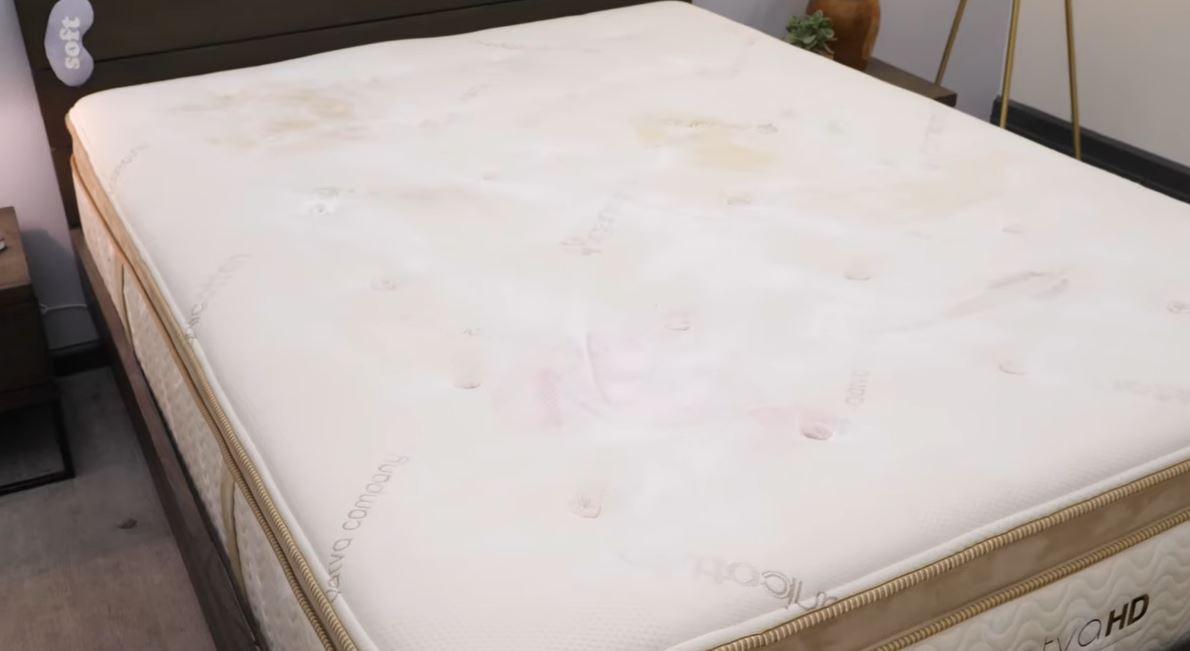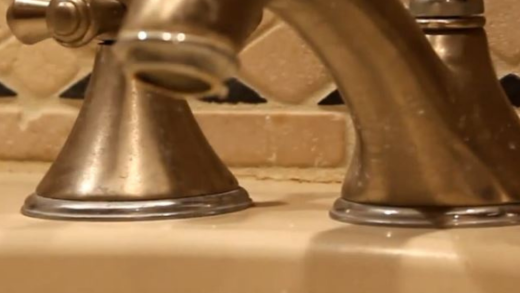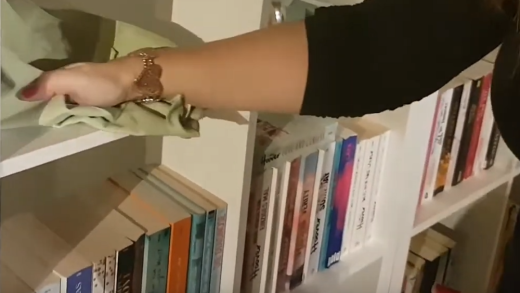A mattress is a serious investment, so you want to make sure it lasts—and that means learning how to clean a mattress. Luxury and affordable mattresses alike can harbor dust mites, dead skin, dirt, and other debris, which means they need to be cleaned regularly—particularly if you suffer from allergies, have pets, or are just an avid midnight snacker.

The good news is that cleaning a mattress is far easier than you might think. Read on to discover the nine simple steps that will help you keep your mattress clean and ready for years of snoozing. Thanks to expert insights from Ed Curry, former president of mattress company Duxiana, Neil Parikh, cofounder of Casper, and Rechelle Balanzat, founder and CEO of professional laundry and dry cleaning service Juliette, here are some pro tips for taking good care of your mattress so you can sleep easy.
1. Gather your mattress cleaning supplies
To deep-clean a mattress, you’ll need certain materials on hand. Gather up:
- Vacuum with an upholstery attachment
- Enzyme cleaner or dish soap to get stains out
- Laundry detergent
- Baking soda
- Cleaning cloths
- Cold water
- Spray bottle
- Handheld steam cleaner
2. Strip the bed and wash all the bedding
Remove sheets, pillowcases, and mattress covers and let them take a spin in the washing machine while you work on cleaning the mattress. Washing all the bedding in hot water will help get rid of any dust mites. Depending on the type of bed pillows you have, you may be able to wash them as well. (If you’re uncertain, make sure to double-check the care label and study up on how to wash pillows.)
3. Vacuum the mattress
Grab your vacuum cleaner’s upholstery attachment and go over the entire surface of the mattress, including the sides. Pay special attention to seams and break out the crevice attachment to get any hidden dirt or dust. You should incorporate vacuuming your mattress monthly into your routine, according to Balanzat: “A quick vacuuming session also helps maintain cleanliness between deep cleans,” she says.
4. Spot-clean your mattress with a stain remover
Now it’s time to focus on the proper care instructions to get stains out of the mattress, and that means spot-cleaning. Never soak your mattress or apply water or cleaning solution directly to it. Memory foam, for example, isn’t supposed to get wet at all. For that reason, it’s important to proceed with caution and operate on the principle that less is more.
So spot-cleaning with a stain remover it is. The stain remover you choose will depend on the type of stain and the type of mattress. For biological stains, reach for an enzyme cleaner. Spray the cleaner onto a clean white cloth, and then blot the stained area with the damp cloth. After that, you can apply cold water to a different clean cloth and continue blotting until the stain lifts. The goal here is to use as little product and moisture as possible. This method is ideal for blood, sweat, vomit, urine, and other related stains.
As an alternative to an enzyme-based cleaner, you can make your own DIY solution by mixing dish soap with water and applying just the resulting foam to the stain. You can also make a DIY solution of equal parts cold water and hydrogen peroxide, or use a vinegar-baking-soda solution to remove stains.
5. Sprinkle baking soda all over the entire mattress
If you can’t put your mattress out in the sun and fresh air, baking soda is the next best thing. Sprinkle a layer over the entire top of the mattress and leave for several hours (or better yet, apply before an overnight trip). Baking soda will break down acid and absorb any remaining moisture or odor. The longer you can leave baking soda on the mattress, the better it will work! As the mattress sits with the baking soda, open any windows in the room to let the light and sunshine in. The sun’s UV rays will actually help kill any mold or bacteria on the mattress.
6. Vacuum again
Once the baking soda has worked its magic, thoroughly vacuum it up. (If you have a fabric headboard, now’s a good time to vacuum that as well! Might as well get a fresh start with everything bed-related.) One optional step? “A handheld steam cleaner can help sanitize and remove deep-seated grime,” Balanzat says.
7. Flip the mattress
Now that side one is spotless, flip the mattress and repeat steps 1 through 5 so both sides are equally fresh and clean. Flipping, of course, should be done at regular intervals, whether you’re deep-cleaning the mattress or not. The conventional wisdom has been that people should flip their mattress every three to six months to prevent uneven wear, but that rule of thumb only applies to spring mattresses because they compress over time. As mattresses get more specialized, like with hybrid mattress designs, your best bet is to check with the model manufacturer. The foam Casper mattress, for instance, only needs to be rotated 180 degrees every few months, while only the top pad of Duxiana’s Dux mattress needs to be flipped and turned.
As a general rule of thumb, even the best mattresses should be flipped or rotated every three months—or more often if you start to notice any sagging. And for those who share a bed, a mattress for couples can really benefit from these regular adjustments to make sure both sides of the bed wear evenly and extend the overall lifespan of the mattress.
There are some mattress styles that don’t require the heavy lifting required to flip a mattress. Casper mattresses, for instance, only need to be rotated 180 degrees every few months—a.k.a., move the mattress around so your head goes where your feet were before.
8. Protect the mattress
Now that you know how to clean a mattress, it’s time to protect it. Once it’s fully dry, cover your fresh, clean mattress with a waterproof mattress protector, which will make cleaning easier in the future and protect from spills, dirt, allergens, and other unpleasantries (i.e. bed bugs).
Most brands sell mattress protectors, and if you buy a mattress on Amazon, you can usually snag a deal on a mattress protector in the related products section.
Balanzat also recommends supporting your mattress with a solid bed frame or box spring, and keeping your mattress as dry as possible. “Avoid excess moisture by ensuring proper ventilation and addressing spills immediately,” she says.
9. Keep out dust with a fitted sheet
“Using fitted sheets that are regularly washed and keeping the area around the mattress clean should protect it from any dust,” Parikh says. That said, wrapping mattresses and box springs in mattress encasements ensures that dust mites don’t take up residence, Curry says—an especially good idea for those who suffer from allergies or asthma.
Along with your bed sheets, Balanzat says your regular mattress maintenance should include cleaning pillowcases and blankets weekly in hot water to reduce dirt and bacteria.
Just make sure the encasement is flexible enough to stretch as your body sinks into the bed, which is especially important for side sleepers. (Back sleepers and stomach sleepers don’t need as much cushioning, so this isn’t an issue for them.)
Cleaning a mattress will no doubt extend its life and make it a treat to sleep on, but all good things must come to an end. There are different “lifespans” for a clean mattress, and depending on the type of mattress, Balanzat says to look for a new mattress once you’ve reached the following timeframes:
- Memory foam and latex mattresses: 7 to 10 years
- Innerspring and hybrid mattresses: 5 to 8 years
- Waterbed and airbed mattresses: 7 to 9 years
- Adjustable bed mattresses: 8 to 12 years (Warning: Some components may wear out sooner with these types of mattresses)
On average, you should consider investing in a new mattress every eight years or so. Body impressions and sagging indicate that it’s no longer providing adequate support, Curry says. “It’s also important to listen to your body,” Parikh says. “Waking up in pain or sleeping poorly every night are signs that it’s time to move on.”
How to know when it’s time to clean your mattress
Before you complete the steps above, you should look for warning signs that it’s time to give your mattress a good cleaning. Balanzat says there’s one general hygiene note: If you haven’t cleaned your mattress in over six months, you’re officially overdue for a cleaning. Before then, these are a few other signals:
- There are visible stains or discoloration on your mattress
- You can smell odors, especially musty or sour smells
- Your allergy symptoms are worsening (due to dust mites, pet dander, or mold)
- You’ve noticed an increase in dust or debris on your bedding


